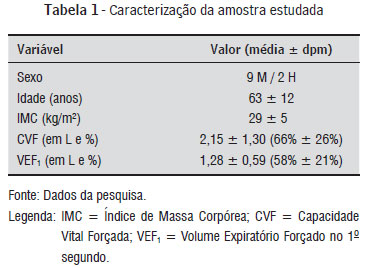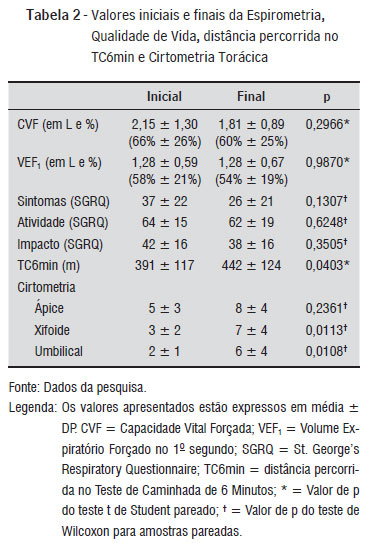BACKGROUND: Chronic Obstructive Pulmonary Disease produces mechanical changes in chest wall and this physical disability reduces the daily life activities and quality of life levels. OBJECTIVES: To assess the effects of an exercise program for Thoracopulmonary Complex Re-Adaptation in the chest wall mobility, exercise capacity and quality of life in COPD patients. MATERIALS AND METHODS: Thirteen COPD patients were studied. Spirometry, Six Minutes Walk Test, Thoracic Mobility and Quality of Life by Saint George Respiratory Questionnaire (SGRQ) were the variables. The exercise program was created based on physical exercises that aim at increasing the thoracic mobility and a better exercise tolerance, as well as improving the subjective response related to quality of life. RESULTS: After a 12-week program, it was observed a significant improvement in chest wall mobility in lower chest region (xiphoid level mobility: from 3 ± 2 cm to 7 ± 4 cm; p = 0.01) and in the abdominal region (umbilical level mobility: from 2 ± 1 cm to 6 ± 4 cm; p = 0.01). There was a statistically significant improvement of exercise capacity (walk distance: from 391 ± 117 m to 442 ± 124 m; p = 0.04). In quality of life assessment by SGRQ, there was a tendency of improving in three domains (symptom: from 37 ± 22 to 26 ± 21; activity: from 64 ± 15 to 62 ± 19; and impacts: from 42 ± 16 to 38 ± 16), but with no statistic significances. CONCLUSION: Respiratory exercises aimed at increasing the chest wall mobility improve abdominal and lower chest expansibility and exercise tolerance.
Chest wall mobility; Physical therapy; COPD


